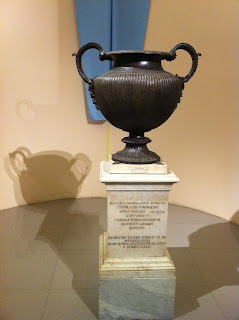Wednesday, October 19, 2011 -  Chiaramonti Museum,Hercules,Mithradates,Pergamon,Telephus,Vatican Library
Chiaramonti Museum,Hercules,Mithradates,Pergamon,Telephus,Vatican Library
 No comments
No comments
 Chiaramonti Museum,Hercules,Mithradates,Pergamon,Telephus,Vatican Library
Chiaramonti Museum,Hercules,Mithradates,Pergamon,Telephus,Vatican Library
 No comments
No comments
The Collecting History of Stolen Art: Hercules and his son Telephos in the Chiaramont Museum inside the Vatican
ARCA Blog Editor-in-Chief
Updated August 19, 2013
Even the Roman general Pompey wanted a souvenir when he defeated Mithradates VI of Pontus and brought the Kingdom of Armenia into the Roman Empire.
In The Poison King: The Life and Legend of Mithradates: Rome's Deadliest Enemy (Princeton University Press, 2009), Adrienne Mayor has a photo of Hercules and his son Telephus in the Chiaramonti Museum at the Vatican. This sculpture shows Hercules in a lion-skin cape holding an infant. Ms. Mayor writes: "Recent analysis of portraiture in contemporary coins and sculpture suggests that the model for the little boy was none other than Mithradates!"
Pompey the Great recognized the likeness of the baby Telephus to Mithradates and took it to Rome after defeating Mithradates in 63 BC (Mayor): "Pompey installed this Hercules statue in his Theater on the Field of Mars in Rome. The statue was discovered in 1507 in Campo dei Fiori, near the ruins of Pompey's Theater."
The 19th century Chiaramonti Museum, one of the buildings known as the Vatican Museum set up more than 500 years ago.
In August 2013, when I revisited this subject, I found an image of the sculpture of "Heracles with infant Telephos" on the website of the Chiaramonti Museum. When I first wrote about this work in 2011 after reading Ms. Mayor's biography of Mithradates on the sculpture of "Heracles with infant Telephos", the Chiaramonti had no such entry. The Chiaramonti writes that "Heracles with infant Telephos" is a second century AD copy.
Telephos became King of Mysia and one of the leading characters in a rich and complex mythology that sees him involved in the Greek expedition against Troy. This statue is a second century A.D. copy, probably of a Late Hellenistic original.
In The Poison King: The Life and Legend of Mithradates: Rome's Deadliest Enemy (Princeton University Press, 2009), Adrienne Mayor has a photo of Hercules and his son Telephus in the Chiaramonti Museum at the Vatican. This sculpture shows Hercules in a lion-skin cape holding an infant. Ms. Mayor writes: "Recent analysis of portraiture in contemporary coins and sculpture suggests that the model for the little boy was none other than Mithradates!"
 |
| Heracles with infant Telephos |
The 19th century Chiaramonti Museum, one of the buildings known as the Vatican Museum set up more than 500 years ago.
In August 2013, when I revisited this subject, I found an image of the sculpture of "Heracles with infant Telephos" on the website of the Chiaramonti Museum. When I first wrote about this work in 2011 after reading Ms. Mayor's biography of Mithradates on the sculpture of "Heracles with infant Telephos", the Chiaramonti had no such entry. The Chiaramonti writes that "Heracles with infant Telephos" is a second century AD copy.
Heracles with infant Telephos
Cat. 1314
This statue, which was discovered in Rome in the vicinity of Campo de' Fiori, was one of the first sculptures to come into the Vatican collections. Pope Julius II (1503-1573) exhibited it in the Courtyard of the Statues in the Belvedere. The presence of Heracles, in fact, leads us back to the mythological origins of Rome, and alludes in particular to the victory of the Romans over the tribes of ancient Latium. The god Heracles, with his club and lion skin, holds his son Telephos in his arms. Telephos is the son born to Heracles by the priestess Auge who was forced to abandon the child in the mountains of Arcadia, where he was nourished by a doe until he was rescued by his father.
Telephos became King of Mysia and one of the leading characters in a rich and complex mythology that sees him involved in the Greek expedition against Troy. This statue is a second century A.D. copy, probably of a Late Hellenistic original.





